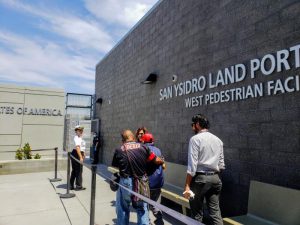Binational Health Month: Strengthening U.S.-Mexico Public Health Collaboration
Posted on byIn October, the Southern Border Health and Migration Branch (SBHMB) within CDC’s Division of Global Migration Health (DGMH) recognized Binational Health Month (BHM). BHM is an annual celebration to promote the health of Mexican and other Latin-American migrants in the United States and Mexico, as well as their countries’ shared commitment to improving public health.

Improving migrant health not only benefits migrant populations but also has social and economic effects on communities in the United States and countries of origin. SBHMB Epidemiologist, Dr. Sonia Contreras, says BHM is “a unique opportunity for government and community-based health organizations to get together to renew and expand their partnerships and commitments to serve Mexican and other Latin American migrant communities that are disproportionately affected by adverse health outcomes and face barriers to accessing care.”
Participating organizations provide culturally and linguistically sensitive health screenings, vaccinations, insurance referrals, and workshops at health events, often held at Mexican Consulates. Over 300,000 people benefit from BHM activities each year. Because of its history of success, other Latin American countries have joined BHM efforts.
Mexican Migrants in the United States
Nearly 11 million Mexican migrants make up the largest foreign-born community living in the United States. Mexican migrants are healthier in some ways when compared to non-Hispanic whites and U.S.-born Mexican Americans, such as:
However, they experience disparities in other health conditions, including some infectious diseases like tuberculosis (TB) and occupational health issues. Mexican migrants also experience inequities in access to health care and preventive services. Lower rates of health insurance, higher poverty rates, immigration status, and cultural and language barriers contribute to these health disparities.
Additionally, there are over two million agricultural workers in the United States, many of whom were born in Mexico. Mexican farmworkers with a H-2A agricultural worker visa travel for temporary farm work in the United States. H-2A workers may be vulnerable to the spread of disease both on their journey to and while in the United States. Agricultural workers traveling from Mexico are at high risk of respiratory virus infections such as COVID-19, influenza, and respiratory syncytial virus (RSV) due to overcrowded working and living conditions, underlying chronic conditions, and limited access to health care.
How SBHMB Works to Address Infectious Diseases in Binational and Migrant Populations
SBHMB is committed to U.S.-Mexico border and binational health and health equity. SBHMB works to prevent, detect, and respond to the spread of communicable diseases through science, partnership, policy, communication, preparedness, and response.
Binational Border Infectious Disease Surveillance Program (BIDS)
BIDS works closely with U.S. states along the border to strengthen binational detection, reporting, and prevention of infectious diseases. Its objectives include:
- strengthening binational communication
- enhancing surveillance; and
- developing disease control strategies
CDC Mexico Country Office
The CDC Mexico Country Office provides technical support for:
- investigating and controlling binational disease outbreaks
- enhancing laboratory capacity and illness response; and
- communicating with U.S. and foreign government officials on policy initiatives critical to binational public health
CureTB Program
CureTB coordinates care for people with TB in the United States who are moving, traveling, or returning to other countries. CureTB links patients to care in many countries, including Mexico. This initiative reduces the spread of TB and the emergence of drug-resistant TB globally.
SBHMB also partners with other public health organizations to address binational and migrant populations’ health concerns.
Binational Technical Working Group
This multidisciplinary group that includes federal, state, and regional public health professionals, meets monthly to discuss binational public health matters. Exchanging epidemiological information promotes collaboration and coordination to address border and binational health issues.
Farmworker-serving Organizations
SBHMB has established a multi-year partnership with the National Center for Farmworker Health, a non-governmental organization, to enhance access to education and preventive services among farmworkers in the United States.
Ventanillas de Salud Program
SBHMB collaborates with the Ventanillas de Salud Program which facilitates health education in Mexican consulates and through mobile units across the United States.
Working Together for a Healthier Future
Binational Health Month demonstrates the collaboration between the United States and Mexico in addressing public health challenges among a shared population. With the support and dedication of binational partners, SBHMB takes strides toward a healthier future for the United States, including migrant communities. This annual event reminds us that, by working together, we can promote health, prevent diseases, and empower our communities to lead healthier lives.
What are some ways you support binational health in your community? Share your thoughts!



Post a Comment